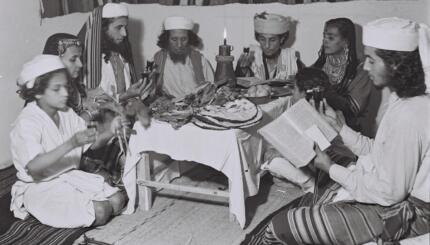Mitzrayim, the Hebrew word for Egypt, is also interpreted to mean “narrow places.” At Passover, we celebrate being released from the restrictions that limit us and make our lives smaller. We are not fully free as long as we are kept down by attitudes and conditions that are unjust.
Many Jews assume that “real Jews” look a certain way and have one path to Judaism — being born Jewish. When confronted with Jews who don’t fit these stereotypes, even well-meaning Jews may treat them as less Jewish. Jews of color and/or those who have converted to Judaism find that other Jews can act insensitively out of ignorance.
In the biblical book that bears her name, Ruth is a Moabite who marries an Israelite living in Moab. After her husband’s death, Ruth insists on accompanying her Israelite mother-in-law, Naomi, when she returns to Israel. There she cares for Naomi and ends up marrying one of her relatives. Because of Ruth’s declaration to Naomi: “Wherever you go, I will go; wherever you lodge, I will lodge; your people shall be my people, and your God my God” (Ruth 1:16), she is considered the prototypical convert to Judaism. Ruth becomes the great-grandmother of King David, from whom our tradition says the Messiah will descend.
The following ritual—Ruth’s Cup—may be added after Elijah’s Cup or anywhere in the seder. Download a copy here to bring to your seder.
It honors not only those who have converted to Judaism, but the overall diversity of the Jewish people:
Leader
At Passover we fill a cup with wine for Elijah and open the door to welcome him to our seder. Elijah symbolizes our hope for the Messianic age, when the world will be perfected, and all people will live in harmony and peace.
We also fill a cup of wine for Ruth, the first Jew by choice and great-grandmother of King David. We open the door to signify our welcome of Ruth and all who follow in her footsteps—those who become part of our people, part of our diversity.
All rise, face the open door, and read together:
We declare that we do not have to wait for the Messianic age to make sure that every Jew feels fully comfortable and integrated into our people, no matter what their skin, hair or eye color is; no matter what their name sounds like; no matter how they became Jewish—through birth or through conversion, as a child or as an adult.
Close the door and be seated.
May your Passover be liberating and enlightening!
____________________________________________
Optional discussion question – Share a time when you felt like an outsider but were actively welcomed into a new community or space. How did that happen? How did it make you feel?



